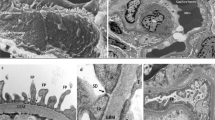Abstract
Background
Congenital nephrotic syndrome (CNS) is primarily a monogenetic disease, with the majority of cases due to changes in five different genes: the nephrin (NPHS1), podocin (NPHS2), Wilms tumor 1 (WT1), laminin ß2 (LAMB2), and phospholipase C epsilon 1 (PLCE1, NPHS3) gene. Usually CNS is not responsive to immunosuppressive therapy, but treatment with ACE inhibitors, AT1 receptor blockade and/or indomethacin can reduce proteinuria. If the disease progresses to end-stage renal disease, kidney transplantation is the therapy of choice.
Case-Diagnosis
Here, we present the case of a 4-month-old girl with congenital nephrotic syndrome. Upon admission, the patient presented with life-threatening anasarca, hypoalbuminemia, proteinuria, and impaired growth. There was no evidence of an infectious or immunological etiology. The genetic evaluation revealed a heterozygous variant in NPHS1 (p.Arg207Trp), in NPHS2 (p.Ser95Phe) as well as in PLCE1 (p.Ala1045Ser) and did not explain CNS. In addition to daily parenteral albumin infusions plus furosemide, a pharmacological antiproteinuric therapy was started to reduce protein excretion. Based on the genetic results, immunosuppressive therapy with prednisolone was initiated, but without response. However, following cyclosporine A treatment, the patient achieved complete remission and now has good renal function, growth, and development.
Conclusions
A profound search for the cause of CNS is necessary but has its limitations. The therapeutic strategy should be adapted when the etiology remains unclear.

Similar content being viewed by others
References
McCaffrey J, Lennon R, Webb NJ (2016) The non-immunosuppressive management of childhood nephrotic syndrome. Pediatr Nephrol 31:1383–1402
Wang JJ, Mao JH (2016) The etiology of congenital nephrotic syndrome: current status and challenges. World J Pediatr 12:149–158
Kari JA, Montini G, Bockenhauer D, Brennan E, Rees L, Trompeter RS, Tullus K, Van't Hoff W, Waters A, Ashton E, Lench N, Sebire NJ, Marks SD (2014) Clinico-pathological correlations of congenital and infantile nephrotic syndrome over twenty years. Pediatr Nephrol 29:2173–2180
Andolino TP, Reid-Adam J (2015) Nephrotic syndrome. Pediatr Rev 36:117–125 quiz 126, 129
Weber S, Buscher AK, Hagmann H, Liebau MC, Heberle C, Ludwig M, Rath S, Alberer M, Beissert A, Zenker M, Hoyer PF, Konrad M, Klein HG, Hoefele J (2016) Dealing with the incidental finding of secondary variants by the example of SRNS patients undergoing targeted next-generation sequencing. Pediatr Nephrol 31:73–81
Battelino N, Arnol M, Kandus A, Ponikvar R, Novljan G (2016) Post-transplant recurrence of focal segmental glomerulosclerosis in a child with heterozygous mutations in NPHS1 and NPHS2. Ther Apher Dial 20:312–317
Suvanto M, Patrakka J, Jahnukainen T, Sjostrom PM, Nuutinen M, Arikoski P, Kataja J, Kestila M, Jalanko H (2017) Novel NPHS2 variant in patients with familial steroid-resistant nephrotic syndrome with early onset, slow progression and dominant inheritance pattern. Clin Exp Nephrol 21:677–684
Feng DN, Yang YH, Wang DJ, Meng DC, Fu R, Wang JJ, Yu ZH (2014) Mutational analysis of podocyte genes in children with sporadic steroid-resistant nephrotic syndrome. Genet Mol Res 13:9514–9522
Inaba A, Hamasaki Y, Ishikura K, Hamada R, Sakai T, Hataya H, Komaki F, Kaneko T, Mori M, Honda M (2016) Long-term outcome of idiopathic steroid-resistant nephrotic syndrome in children. Pediatr Nephrol 31:425–434
Buscher AK, Beck BB, Melk A, Hoefele J, Kranz B, Bamborschke D, Baig S, Lange-Sperandio B, Jungraithmayr T, Weber LT, Kemper MJ, Tonshoff B, Hoyer PF, Konrad M, Weber S (2016) Rapid response to cyclosporin A and favorable renal outcome in nongenetic versus genetic steroid-resistant nephrotic syndrome. Clin J Am Soc Nephrol 11:245–253
Trautmann A, Bodria M, Ozaltin F, Gheisari A, Melk A, Azocar M, Anarat A, Caliskan S, Emma F, Gellermann J, Oh J, Baskin E, Ksiazek J, Remuzzi G, Erdogan O, Akman S, Dusek J, Davitaia T, Ozkaya O, Papachristou F, Firszt-Adamczyk A, Urasinski T, Testa S, Krmar RT, Hyla-Klekot L, Pasini A, Ozcakar ZB, Sallay P, Cakar N, Galanti M, Terzic J, Aoun B, Caldas Afonso A, Szymanik-Grzelak H, Lipska BS, Schnaidt S, Schaefer F (2015) Spectrum of steroid-resistant and congenital nephrotic syndrome in children: the PodoNet registry cohort. Clin J Am Soc Nephrol 10:592–600
Klaassen I, Ozgoren B, Sadowski CE, Moller K, van Husen M, Lehnhardt A, Timmermann K, Freudenberg F, Helmchen U, Oh J, Kemper MJ (2015) Response to cyclosporine in steroid-resistant nephrotic syndrome: discontinuation is possible. Pediatr Nephrol 30:1477–1483
Faul C, Donnelly M, Merscher-Gomez S, Chang YH, Franz S, Delfgaauw J, Chang JM, Choi HY, Campbell KN, Kim K, Reiser J, Mundel P (2008) The actin cytoskeleton of kidney podocytes is a direct target of the antiproteinuric effect of cyclosporine A. Nat Med 14:931–938
El-Husseini A, El-Basuony F, Mahmoud I, Sheashaa H, Sabry A, Hassan R, Taha N, Hassan N, Sayed-Ahmad N, Sobh M (2005) Long-term effects of cyclosporine in children with idiopathic nephrotic syndrome: a single-centre experience. Nephrol Dial Transplant 20:2433–2438
Fujinaga S, Shimizu T (2013) Chronic cyclosporine-induced nephrotoxicity in children with steroid-resistant nephrotic syndrome. Pediatr Nephrol 28:2065–2066
Acknowledgements
We thank the patient and her parents for participating in this study.
Author information
Authors and Affiliations
Corresponding author
Ethics declarations
Conflict of interest
The authors declare that they have no conflict of interest.
Rights and permissions
About this article
Cite this article
Eichinger, A., Ponsel, S., Bergmann, C. et al. Cyclosporine A responsive congenital nephrotic syndrome with single heterozygous variants in NPHS1, NPHS2, and PLCE1. Pediatr Nephrol 33, 1269–1272 (2018). https://doi.org/10.1007/s00467-018-3961-z
Received:
Revised:
Accepted:
Published:
Issue Date:
DOI: https://doi.org/10.1007/s00467-018-3961-z




